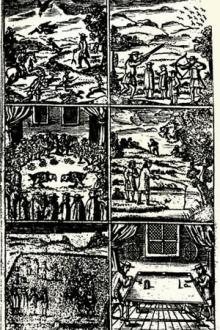The School of Recreation, Robert Howlett [general ebook reader .TXT] 📗

- Author: Robert Howlett
- Performer: -
Book online «The School of Recreation, Robert Howlett [general ebook reader .TXT] 📗». Author Robert Howlett
3. Half Files.
4. Bringers up.
Here they are held to double when the Rear is doubled into the Front. 5. In doubling the Rear observe it done, when the half Files double the Rear.
6. Here take notice that doubling of half Ranks must be by one Rank doubling the other.
This Science, if well understood, as to the fining and using it, is not only a noble Exercise, but of great importance to the saving our lives on emergent Occasions, if it extend not to Vain-glory and Presumption, by too much relying on our Skill, to carry us into quarrels, which we may reasonably, and without loss of Honour or Reputation avoid. Wherefore I have thought it convenient to lay down such Rules as may enable the learner to proceed in the Practice.
The first thing to be considered in this Case, is, the Sword it self, understanding only in this the small Sword or Rapier, which is divided into two Parts, viz. The Hilt and the Blade.
The Hilt is again divided into three Parts, viz. the Pommel or Ball at the far end, sometimes Round and sometimes Oval in Shape. This keeps the Hilt fast, by being well riveted, and by its poise makes the Sword well mounted, or light before the Hand. The next is that part on which you grasp your Hand, commonly called the Handle: and then the Shell, which is that part of the Hilt next the Blade, to preserve your Hand (if you are any thing weary in managing it) from a Thrust or Blow.
The Blade is divided into two Parts only. The first next to the Hilt, being termed the strong Part or Fort. The other, which is the extream, is termed the Feeble, or they are otherways termed the Prime, and the Second. The strong Fort or Prime of the Blade, is measured from the Shell to the middle of the Blade, and being the strongest, is made use of in Parying, or to put by Thrusts or Blows. The Feeble, weak or second part, is accounted from the Middle to the Point, and is properly made use of in Offending or giving Thrusts or Blows; and thus much may serve for the Description of the Sword: Now I proceed to the Explanation of the Terms, fit to be known by a Practitioner.
A Guard.
This is a proper Posture you must place your self in, for the better defending your self from the Thrusts or Blows of those you Fence with, or defend your self from.
To Parie.
Observe that this is to put by a Blow or Thrust, that it may not touch you, but be cast off without hurt or danger.
Quart.
Here you must hold the Nails of your Sword-hand upwards, with a steady Arm; and then it is said to be held in quart.
Terce.
This is the contrary to the former, for the Nails of your Hand must be held downwards; and then the Sword is held in Terce.
Within the Sword.
This is that part of your Body, (which having your Right-side towards your Adversary) is between your Sword and Left-breast.
Within the Sword.
This is the part of the Body, that (when you hold your Sword towards your Left-side) is above it the breadth of your Body.
The Approach or Advance.
This is done, when being out of your Adversaries reach, or at a pretty distance from him; you make your Approach or Advance towards him.
To Retire or Retreat.
This is when you are within your Adversaries reach, that you get put of it by stepping or Jumping backwards; which you must observe to do on a strait Line.
Measure.
This is only a distance between you and your Adversary, which must be cautiously and exactly observed when he is Thrusting at you; so that you may be without his measure or reach, and that taking the Advantage of this, it may be so, that when you Thrust your Thrusts may be home.
To break Measure.
Observe here, just as your Adversary is Thrusting at you, at his full Elonge, he may come short of you, because you are, or escape out of his Measure, or reach, and so break his Measure, of which I shall say somewhat more hereafter.
To Elonge.
This is to Streach forward your Right Arm and Leg, and keep a close Left-foot; and this you do when you give in a Thrust, and when you do it, you are said to make an Elonge.
Respost.
This is when you give in a Thrust before you recover your Body, receiving a Thrust after your Adversary hath Paried your Sword. Then is it said to be a Thrust on the Respost or back of the Parade, which is the surest and safest you can give.
Feinting or Falsifying.
This is a dodging or deceiving your Adversary, making him believe you give back in earnest, and make an offer to Thrust in one place when you really design to do it in another.
Beating.
This is no other than striking the Feeble of your Adversaries Sword with the Edg and Fort of yours, either with your Right-hand only, or the help of your Left, joyned to the Blade, about a foot from the Hilt; and so you will cause the Beat to have the greater Spring or Force.
Battery.
The difference from Beating in this, is only Striking with the Edg of the Feeble, upon the Edg of the Feeble of your Adversaries Sword, though Beating secures his Sword a great deal better than Battery.
Binding.
This method is taken to secure your Adversaries Sword, with eight or ten Inches of yours upon five or six Inches of his.
Caveating or Disengaging.
Here you must, if you can, flip your Adversaries Sword, when you perceive him about to bind or secure yours.
To take Time.
In taking Time, you must observe never to Thrust, but when you see a fair Opportunity, or otherwise it is the Thrusting at your Adversary when he is making the Feint, or the flipping of him, when you perceive him about to Bind or Bear your Sword.
Counter Temps.
This is when you Thrust without a good Opportunity, or when you Thrust, at the same time your Adversary do's the like.
Quarting on the Strait Line.
This is done by carrying your Head and Shoulders very much back from your Adversaries Sword, and are giving in a Thrust within it, and that each of you at that time receive a Thrust.
Quarting of the strait Line, called de Quarting.
Here you must Observe to throw in your Left-foot, and Body backwards off the strait Line, towards your Adversary, keeping your Right-foot firm.
Volting.
This is a leaping by your Adversaries Left-side quite out of his reach or measure, which on many emergent occasions is very proper.
These Terms a Practitioner must be knowing in before he proceeds to the other Lessons, or Adventures on sharp, especially in earnest; from whence I proceed to the next thing materially to be considered, which is the
Holding of the Sword.
In doing this according to Art, and to the most advantage, Hold your Thumb on the broad side of the Handle, and your Fingers quite round it; hold it in this manner firm and fair; so that your Adversary, with the least sudden beat or twist, may not force it out of your hand, which the hazard in holding it loosely may occasion to your damage.
Of keeping a Guard.
The Guards are in general but two; The one in Quart and the other in Terce; but again the Quart Guard is subdivided into two, viz. The Quart with the strait Point, and the Quart with the Point sloaping near to the Ground.
The Terce is so likewise divided, that is, the Terce with the Point higher than the Hilt, and the Terce with the Point lower than the Hilt. There is yet another Guard, that requires you to hold your Sword with both your Hands; and of these in their order.
Of the Quart Guard, with the strait Point.
You have two ways with this Guard to defend your self, either by Parying or using Contraries to what your Adversary plays, as I shall more fully shew you when I come to discourse of the five Parades; however here observe in the strait Guard, which is most in use, to keep a thin Body, which is done by shewing your Right-side to your Adversary, managing your feet in a strait Line from him; so that for your Right he cannot see your Left-leg, yet set them not too wide, for that will make your Elong the shorter; nor too close, for that will hinder the firmness of standing; and let the Point of your Right foot be turned somewhat outwards from the strait Line, but the broad side of your Left must look towards your Adversary. You are also to sink with your Thighs your Left-knee, a little more bent than your Right, which may be done by your leaning somewhat back on your Left-thigh; when you present your Sword, you must hold it with your Nails upwards, as has been directed in Quart. The Hilt of your Sword must be as High as your Right-pap, keeping your Arm a little bent, for the better and easier pursuing your Adversary; or for the quicker giving in a Thrust: The Point must be towards your Adversaries Right-side, two or three Inches lower than the Hilt, your Left-hand held up as high as your Left-ear, about half a Foot from it, the Palm directly against your Adversaries Face, your Fingers pointing as it were towards him.
The Quart-guard, with the sloping Point.
In this Guard you must stand much straiter than in the former, the Point of your Sword sloping within half a Foot of the Ground, your Hilt as low as your Wast, your Arm bended, and the Nails of your Sword-hand between Terce and Quart; Here you are also to make use of your Left-hand, and therefore the more readily to do it, you must advance your Left Shoulder almost as far forward as your Right, keeping your Belly in as much as may be, so that it stand well, and your Breast out, your Left-hand as high as the side of your Head, though about half a Foot from it. This is a very open Guard, yet to those that know not how to pursue it, it is much Surprizing. And you may pursue this;
First, by raising up or gathering your Adversaries Sword.
Secondly, by striking at his Sword, and making half Thrusts at the Body, by which he will be doubtful when you intend to give in your Thrust, and finding an Opportunity give it home; and ever when you persue this Guard, let your Left-hand be in a readiness to Parie your Opponents Thrust, if he Thrust just as you are Thrusting, which is the main defence on this Guard.
Thirdly you may give a stroak at his Left-hand; after you give a beat at his sword, and see if by so doing, you can force him to betake himself to another Guard.
Fourthly, You may Volt, and in your so doing, give him the Thrust, which being clearly done, will mainly surprize him.
The-Terce-guard, with the Point higher than the Hilt.
In this you must hold the Nails of your Sword-hand downwards, as in Terce, and your Hand lower than in the Quart-Guard, with a strait





Comments (0)